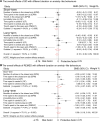Sleep deprivation affects memory function, depression and anxiety-like behaviours in rats and mice: a systematic review and meta-analysis
- PMID: 40994825
- PMCID: PMC12455040
- DOI: 10.1093/braincomms/fcaf309
Sleep deprivation affects memory function, depression and anxiety-like behaviours in rats and mice: a systematic review and meta-analysis
Abstract
Sleep deprivation paradigms have been employed in rat and mouse models to elucidate the function of sleep. The effects of sleep deprivation on memory function, as well as changes in depression- and anxiety-like behaviours, have been extensively investigated; however, the findings have often been inconsistent. In the present study, we conducted a comprehensive literature review of researches utilizing sleep deprivation paradigms in both rats and mice. A total of 164 original studies were analysed to extract results from behavioural tests concerning memory function and depression- and anxiety-like behaviours in wild-type rats or mice before and after sleep deprivation. The meta-analysis revealed that sleep deprivation consistently impaired memory function, irrespective of the paradigms, durations and species involved [P = 0.000, SMD (standardized mean difference) 95% CI (confidence intervals at 95%): -0.73 (-0.89, -0.57) for sleep deprivation; P = 0.000, SMD (95% CI): -0.75 (-0.93, -0.57) for rapid eye movement sleep deprivation]. Similar, albeit less pronounced, effects were observed on depression-like behaviours [P = 0.000, SMD (95% CI): -0.41 (-0.52, -0.29) for sleep deprivation; P = 0.000, SMD (95% CI): -0.60 (-0.79, -0.42) for rapid eye movement sleep deprivation]. The impact of sleep deprivation on anxiety-like behaviours was more variable. When considering both mice and rats, sleep deprivation generally exhibited anxiogenic effects [P = 0.049, SMD (95% CI): -0.19 (-0.39, -0.00) for sleep deprivation; P = 0.705, SMD (95% CI): 0.04 (-0.18, 0.27) for rapid eye movement sleep deprivation]. However, subgroup analyses indicated that rodent species and sleep durations demonstrated distinct responses to sleep deprivation. This study provides critical insights for selecting optimal paradigms, durations, species and behavioural tests in experimental designs.
Keywords: anxiety; depression; memory; sleep deprivation; species.
© The Author(s) 2025. Published by Oxford University Press on behalf of the Guarantors of Brain.
Conflict of interest statement
The authors declare that they have no competing interests.
Figures








References
-
- Van Twyver H. Sleep patterns of five rodent species. Physiol Behav. 1969;4(6):901–905.
-
- Pires GN, Bezerra AG, Tufik S, Andersen ML. Effects of experimental sleep deprivation on anxiety-like behaviour in animal research: Systematic review and meta-analysis. Neurosci Biobehav Rev. 2016;68:575–589. - PubMed
-
- Matenchuk BA, Mandhane PJ, Kozyrskyj AL. Sleep, circadian rhythm, and gut microbiota. Sleep Med Rev. 2020;53:101340. - PubMed
Publication types
LinkOut - more resources
Full Text Sources
